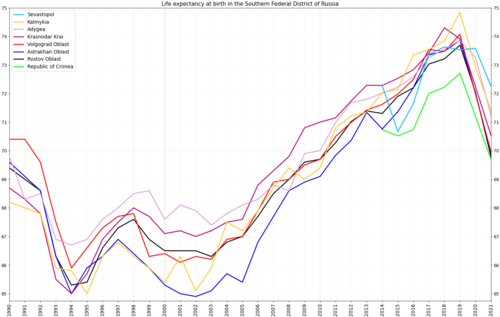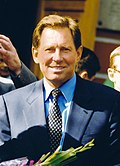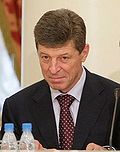Southern Federal District
 From Wikipedia - Reading time: 9 min
From Wikipedia - Reading time: 9 min
Southern Federal District
Южный федеральный округ | |
|---|---|
 Map showing location of Russia's Southern Federal District, in southwestern Russia. (Crimea, whose annexation by Russia from Ukraine is mostly unrecognized internationally, is shown in orange.) | |
| Coordinates: 47°N 42°E / 47°N 42°E | |
| Country | |
| Established | 13 May 2000[2] |
| Administrative centre | Rostov-on-Don |
| Largest city | Krasnodar |
| Government | |
| • Presidential Envoy | Vladimir Ustinov |
| Area | |
• Total | 447,821 km2 (172,905 sq mi) |
| • Rank | 7th |
| Population | |
• Total | 16,319,253[1] |
| • Rank | 4th |
| • Urban | 62.4%[1] |
| • Rural | 37.6%[1] |
| GDP | |
| • Total | ₽ 9.816 trillion US$ 140 billion (2022) |
| • Per capita | ₽ 588,461 US$ 8,419 (2022) |
| Federal constituent entity | 6 contained (12 if including disputed oblasts and republics) |
| Economic regions | 1 contained (2 if containing disputed oblasts and republics) |
| HDI (2022) | 0.764[5] high · 7th |
| Website | ufo |
 | |
The Southern Federal District (Russian: Южный федеральный округ, IPA: [ˈjuʐnɨj fʲɪdʲɪˈralʲnɨj ˈokrʊk]) is one of the eight federal districts of Russia. Its territory lies mostly on the Pontic–Caspian steppe of Southern Russia. The Southern Federal District shares borders with Ukraine, the Azov Sea, and the Black Sea in the west, and Kazakhstan and the Caspian Sea in the east.[6]
History
[edit]The Southern Federal District was originally called the North Caucasian Federal District when it was founded on 13 May 2000, but was renamed for political reasons on 21 June 2000. On 19 January 2010, the Southern Federal District was split in two, with its former southern territories forming a new North Caucasian Federal District.[7]
On 28 July 2016, Crimean Federal District (which contains the Republic of Crimea and the Federal city of Sevastopol) was abolished and merged into Southern Federal District in order to "improve the governance".[8] Crimean Federal District was established on 21 March 2014 after the Annexation of Crimea by the Russian Federation.[9] The federal district includes both the Republic of Crimea and the federal city of Sevastopol, both recognized as part of Ukraine by most of the international community.[10][11] Its population was 13,854,334 (62.4% urban) according to the 2010 Census,[1] living in an area of 420,900 square kilometers (162,500 sq mi).[3]
Demographics
[edit]
Federal constituent entities
[edit]An official government translation of the constitution of Russia from Russian to English uses the term "constituent entities of the Russian Federation". For example, Article 5 reads: "The Russian Federation shall consist of republics, krays, oblasts, cities of federal significance, an autonomous oblast and autonomous okrugs, which shall have equal rights as constituent entities of the Russian Federation."[12] A translation provided by Garant-Internet instead uses the term "subjects of the Russian Federation".[13]
Tom Fennell, a translator, told the 2008 American Translators Association conference that "constituent entity of the Russian Federation" is a better translation than "subject".[14] This was supported by Tamara Nekrasova, Head of Translation Department at Goltsblat BLP, saying in a 2011 presentation at a translators conference that "constituent entity of the Russian Federation is more appropriate than subject of the Russian Federation (subject would be OK for a monarchy)".[15]
| # | Flag | Coat of Arms | Constituent entities | Area in km2[3] | Population | Capital/administrative center | Map of Administrative Division |
|---|---|---|---|---|---|---|---|
| 1 | 
|
Republic of Adygea | 7,800 | 496,934 | Maykop | ||
| 2 | Astrakhan Oblast | 49,000 | 960,142 | Astrakhan | 
| ||
| 3 | 
|
Republic of Kalmykia | 74,700 | 267,133 | Elista | ||
| 4 | 
|
Krasnodar Krai | 75,500 | 5,838,273 | Krasnodar | ||
| 5 | 
|
Rostov Oblast | 101,000 | 4,200,729 | Rostov-on-Don | 
| |
| 6 | 
|
Volgograd Oblast | 112,900 | 2,500,781 | Volgograd | ||
| Disputed territories | |||||||
| A | 
|
Republic of Crimea[a] | 26,100 | 1,934,630 | Simferopol | ||
| B | 
|
Sevastopol[a] | 900 | 547,820 | Sevastopol | 
| |
Ethnic groups
[edit]Ethnic composition, according to the 2010 census: Total - 13 854 334 people.
- Russians - 11,602,452 (83.75%)
- Armenians - 442,505 (3.19%)
- Ukrainians - 212 674 (1.54%)
- Kazakhs - 205 364 (1.48%)
- Kalmyks - 172,242 (1.24%)
- Tatars - 127,455 (0.92%)
- Adyghe (Circassian) - 121 391 (0.88%)
- Azerbaijanis - 52 871 (0.38%)
- Turks - 51,367 (0.37%)
- Roma - 46,067 (0.33%)
- Belarusians - 44 723 (0.32%)
- Chechens - 34,593 (0.25%)
- Georgians - 31,018 (0.22%)
- Germans - 29 312 (0.21%)
- Koreans - 27,640 (0.20%)
- Greeks - 27,313 (0.20%)
- Dargins - 24 815 (0.18%)
- Uzbeks - 16 361 (0.12%)
- Avars - 16,061 (0.12%)
- Moldovans - 15 888 (0.11%)
- Lezgins - 15 241 (0.11%)
- Chuvash - 12 329 (0.09%)
- Kurds - 12,056 (0.09%)
- Bashkirs - 4 942 (0.06%)
- Persons who did not indicate their nationality: 240 609 people. (1.74%)
- Representatives of other nationalities: 729,572 people. (5.26%)
Life expectancy
[edit]
Presidential plenipotentiary envoys
[edit]| № | Name (envoy) | Photo | Term of office | Appointed by | ||
|---|---|---|---|---|---|---|
| Start of term | End of term | Length of service | ||||
| 1 | Viktor Kazantsev | 
|
18 May 2000 | 9 March 2004 | 3 years, 296 days (1,391 days) | Vladimir Putin |
| 2 | Vladimir Yakovlev | 
|
9 March 2004 | 13 September 2004 | 188 days | |
| 3 | Dmitry Kozak | 
|
13 September 2004 | 24 September 2007 | 3 years, 11 days (1,106 days) | |
| 4 | Grigory Rapota | 
|
24 September 2007 | 14 May 2008 | 233 days | |
| 5 | Vladimir Ustinov | 
|
14 May 2008 | present | 17 years, 78 days (6,287 days) | Dmitry Medvedev |
References
[edit]- ^ a b c d Russian Federal State Statistics Service (2011). Всероссийская перепись населения 2010 года. Том 1 [2010 All-Russian Population Census, vol. 1]. Всероссийская перепись населения 2010 года [2010 All-Russia Population Census] (in Russian). Federal State Statistics Service.
- ^ Putin, V. (May 13, 2000). "Указ Президента Российской Федерации о полномочном представителе Президента Российской Федерации в федеральном округе" [Decree of the President of the Russian Federation on the Plenipotentiary Representative of the President of the Russian Federation in the Federal District] (in Russian). Retrieved June 27, 2024 – via Wikisource.
- ^ a b c "1.1. ОСНОВНЫЕ СОЦИАЛЬНО-ЭКОНОМИЧЕСКИЕ ПОКАЗАТЕЛИ в 2014 г." [MAIN SOCIOECONOMIC INDICATORS 2014]. Regions of Russia. Socioeconomic indicators – 2015 (in Russian). Russian Federal State Statistics Service. Retrieved July 26, 2016.
- ^ Валовой региональный продукт по субъектам Российской Федерации в 2016-2022 гг., rosstat.gov.ru
- ^ "Sub-national HDI – Area Database – Global Data Lab". hdi.globaldatalab.org. Retrieved July 20, 2021.
- ^ "Southern Federal District, Russia Guide". russiatrek.org.
- ^ Президент Российской Федерации. Указ №849 от 13 мая 2000 г. «О полномочном представителе Президента Российской Федерации в федеральном округе». Вступил в силу 13 мая 2000 г. Опубликован: "Собрание законодательства РФ", №20, ст. 2112, 15 мая 2000 г. (President of the Russian Federation. Decree #849 of May 13, 2000 On the Plenipotentiary Representative of the President of the Russian Federation in a Federal District. Effective as of May 13, 2000.).
- ^ "Крымский федеральный округ включен в состав Южного федерального округа" (in Russian). Interfax. July 28, 2016. Retrieved July 28, 2016.
- ^ "В России создан Крымский федеральный округ". RBC. March 21, 2014.
- ^ Law about occupied territories of Ukraine. Mirror Weekly. 15 May 2014
- ^ Higher educational institutions at the temporarily occupied territories of Ukraine will not work – the minister of education. Newsru. 1 October 2014
- ^ "Constitution of the Russian Federation". Government of the Russian Federation. Retrieved August 11, 2022.
- ^ "The Constitution of the Russian Federation". Garant-Internet. Retrieved August 11, 2022.
- ^ Knizhnik, Irina (2009). "On legal terminology, the jury is still out" (PDF). SlavFile. 18 (1). Slavic Languages Division, American Translators Association: 20. Archived (PDF) from the original on October 31, 2020. Retrieved August 11, 2022.
- ^ Nekrasova, Tamara (2011). "Traps & Mishaps in Legal Translation" (PDF). Eulita. Retrieved August 11, 2022.
- ^ "Демографический ежегодник России" [The Demographic Yearbook of Russia] (in Russian). Federal State Statistics Service of Russia (Rosstat). Retrieved June 1, 2022.
- ^ "Ожидаемая продолжительность жизни при рождении" [Life expectancy at birth]. Unified Interdepartmental Information and Statistical System of Russia (in Russian). Retrieved June 1, 2022.
External links
[edit]| Federal districts of Russia | |
|---|---|
| North Caucasian | Central | Southern | Northwestern | Far Eastern | Siberian | Ural | Volga | |
 KSF
KSF
